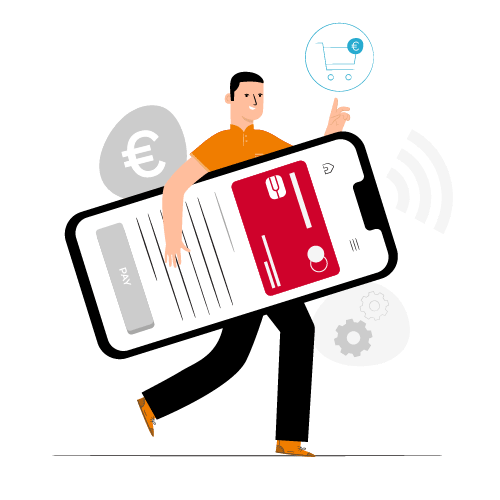Key themes
Innovative
payments

Innovation in the payment industry
The concept of payment has evolved considerably since its inception, from barter to the exchange of cash and cashless payments such as cards. For many years, we have relied on a constant pace of change and traditional solutions to make payments, relying primarily on centralized financial institutions.
Cash and cards still play a major role, especially in Europe. However, over the last decade, payments have evolved at a rapid pace, with the ecosystem enriched by new players, new platforms and new technologies. Changing customer behaviour has always been a transformation driver, but with the effects of the pandemic, change has occurred at an unprecedented pace. Customers have embraced contactless payment solutions as the new standard, and these new habits are no longer reserved for members of Generation Z, but affect all age groups. The health crisis has undoubtedly accelerated payment digitalisation. The rapid transformation underway in payments will continue to intensify:
The dynamics of contactless technology
The current situation has propelled the use of contactless payment and it is unlikely that customers will return to their old habits. The latest research indicates that 79% of card users worldwide now opt for contactless transactions, representing a 40% increases in the number of contactless transactions worldwide during the first quarter of 2020. In addition to physical means such as cards, mobile payments are also gaining ground. Near field communication (NFC) or QR code payments are opening up a multitude of possibilities. Under these changes in proximity buying and payer-paid interactions, mobile wallets are also enriching transaction experiences and purchasing modes.
A driver for new opportunities through instant payments
Instant payments (IP) harbour strong promise through real-time payment processing, 24 hours a day, 365 days a year and with immediate availability to the beneficiary. Instant payment is playing an important role in transforming banks and interbank infrastructures. The first phase of instant payment is the implementation of the SEPA Credit Transfer Instant Payment scheme (SCT-IP), i.e. real-time processing of credit transfers (SCT), and its adoption on a European scale. According to the European Central Bank (ECB), instant payment could account for 23% of all credit transfers in Europe by 2023. However, instant payment is not the ultimate goal, but forms part of the pathway to other value-added services such as request to pay (R2P) or QR codes based on real-time payment capabilities. Using instant payment to underpin the technology paves the way for other innovative solutions that can add further value to businesses and improve customer experience.
Request-to-pay (R2P): modernizing the way we pay
R2P offers a new flexible service for settling transactions either between businesses or between individuals and businesses or between individuals. As an overlay to an existing payment infrastructure, R2P allows an applicant to communicate in real time and send an electronic request to an approver who may be presented with a number of payment choices, such as paying in full, partial payment, requesting an extension, refusing or sending a message.
This new payment service offers real flexibility to the payer in terms of payment choices, but also substantial advantages for the payee, thanks to simplified reconciliation and easier invoice management and consequently cost structure optimisation.
If you want to know more, click here to read our white paper on Request to Pay.
Open banking and payment
The Payment Services Directive (PSD2) is part of the open data banking movement, already initiated by banking mobility services and through the French Digital Republic law dated 7 October 2016. This law has enshrined the right to portability allowing consumers to retrieve their personal data from digital service providers and transfer the data to other providers. This right has since been reinforced by the European General Data Protection Regulation (GDPR), which came into force on 25 May 2018.
The growth of banks’ online services has logically included the banking sector within the scope of application for this new regulatory framework. Since 25 May 2018, the right to portability allows consumers, particularly those using online banking services, to retrieve all of their files or consumption data related to transactions. Online service providers must take all of the necessary measures in this respect, particularly in terms of programming interfaces and providing the information needed to change provider.
This confirms the utility of application programming interfaces (API). APIs and more particularly open APIs appear to be a real alternative to web scraping and provide a balance between security and innovation in account aggregation and payment initiation applications. However, there is still a long way to go to achieve API and data structure standardisation, allowing interoperability between services within the European ecosystem. However, open banking in Europe is becoming a reality, opening up a new era of innovation in financial services and extending the scope for new payment solutions.
If you want to know more, click here to read our white paper on open banking.
Galitt at your side
Galitt helps you understand the new payment model issues facing clients and the opportunities they represent for your business.
-
Offering expert advice on digital payment to help you manage functional, organizational and economic impacts.
-
Helping you to define a European position and a promotion strategy within the framework of market initiatives (EPI).
-
Launching specific payment analyses.
-
Helping you obtain payment institution licences .
-
Guiding you through payment regulation and compliance.
-
Supporting you in defining and implementing your project in order to best meet your commercial and technical needs.

Do you have questions ? Contact us !

Pierre Lahbabi
Galitt – CEO
pierre.lahbabi@galitt.com
+ 33 6 48 70 15 93
